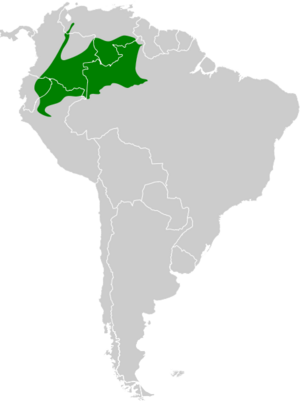Many-banded aracari facts for kids
Quick facts for kids Many-banded aracari |
|
|---|---|
 |
|
| Conservation status | |
| Scientific classification | |
| Genus: |
Pteroglossus
|
| Species: |
pluricinctus
|
 |
|
The many-banded aracari (Pteroglossus pluricinctus) is a colorful bird from the toucan family. It lives in the warm, green forests of South America. You can find this bird in countries like Brazil, Colombia, Ecuador, Peru, and Venezuela.
Contents
About the Many-banded Aracari
This bird is special because it is the only one of its kind (species) in its group. This means there are no different types or subspecies of the many-banded aracari.
What the Many-banded Aracari Looks Like
The many-banded aracari is about 43 to 46 centimeters (17 to 18 inches) long. Its long, colorful bill is about 11 to 12.5 centimeters (4.3 to 4.9 inches) long. This bird usually weighs between 215 and 302 grams (7.6 to 10.7 ounces).
Bill and Face Details
Both male and female aracaris have similar bill colors. The female's bill is a bit shorter. The bill has an orange-yellow line at its base. The top part of the bill is orange-yellow with a wide black stripe. The bottom part of the bill is black. Around the bird's eye, the skin is blue-green or green. There is also a chestnut-colored patch behind the eye.
Body Colors
Adult male aracaris have a mostly black head, throat, and neck. Their back is dark green, and their rump (the area above the tail) is red. Their belly is yellow with two black bands. The lower band also has some red. Their upper legs are a mix of chestnut, green, and yellow.
Female and Young Birds
Adult female aracaris usually have less or no chestnut color behind their eye. Their black chest band is also wider than the male's. Young aracaris look duller than the adults. Their bill is gray, brown, or black, and it does not have the yellow line at the base. Their upper legs are green.
Where the Many-banded Aracari Lives
The many-banded aracari lives in parts of South America. You can find it from northeastern Colombia and Venezuela, south through eastern Ecuador to northeastern Peru. It also lives in northwestern Brazil, north of the Amazon River.
Forest Homes
This bird mostly lives in terra firme forests. These are forests on higher, drier ground that do not flood. It also lives in várzea forests, which are floodplains, and gallery forests, which grow along rivers. They usually live at elevations up to 750 meters (2,500 feet). Sometimes, they can be found as high as 1,000 meters (3,300 feet).
How the Many-banded Aracari Behaves
Movement and Daily Life
Scientists believe that the many-banded aracari stays in the same area all year long. It does not migrate to different places. It usually looks for food alone, in pairs, or in small groups.
What They Eat
The many-banded aracari mainly eats fruits. It is a very important bird for spreading seeds from these fruits. It often spits out the seeds, which helps new plants grow far away. Besides fruit, it also eats insects, small birds, bird eggs, and lizards.
Reproduction and Family Life
The breeding season for the many-banded aracari is thought to be from November to March in Colombia and Ecuador. In other parts of its range, it breeds from March to October. Not much else is known about how these birds raise their young.
Bird Calls
The many-banded aracari makes different sounds. People describe its calls as "seeent," "seeet," "see-yeet," "kyseek," and "kyeek."
Status of the Many-banded Aracari
The IUCN (International Union for Conservation of Nature) has listed the many-banded aracari as a species of "Least Concern." This means it is not currently in danger of disappearing. It lives across a very large area. However, we do not know exactly how many of these birds there are. Their numbers are thought to be slowly going down.
Conservation Efforts
This bird is described as "fairly common" in countries from Colombia to Peru. But in other areas, not much is known about its population. The many-banded aracari lives in several protected areas. More information about its life and how many birds there are would be helpful for protecting the species in the future.


